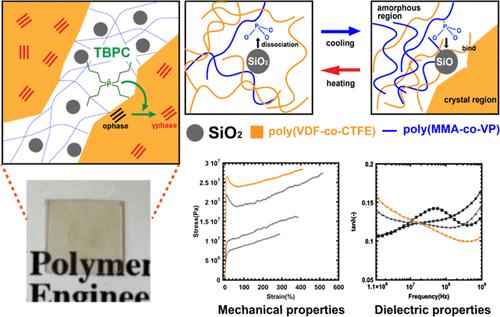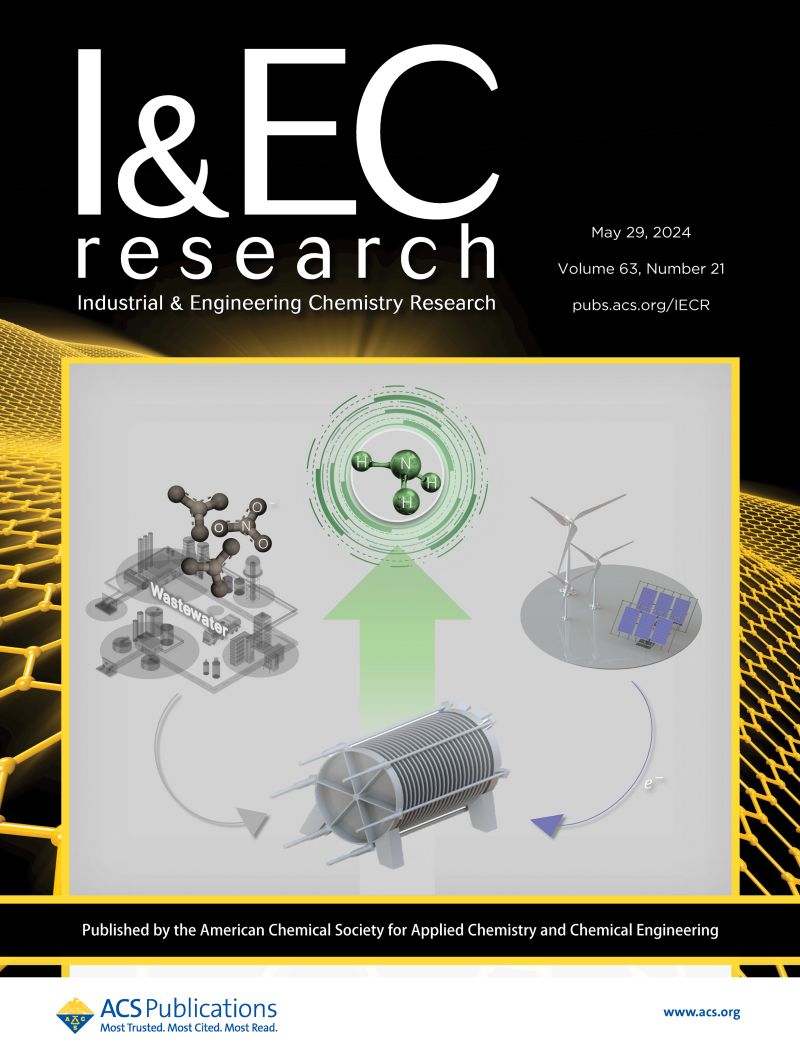设计和开发三维网络混合聚合物系统,通过聚偏二氟乙烯-四氟乙烯(PVDF-CTFE)的选择性γ晶体生长和降低高频弛豫来增强介电性能
IF 3.9
3区 工程技术
Q2 ENGINEERING, CHEMICAL
引用次数: 0
摘要
在聚(偏二氟乙烯)(PVDF)及其共聚物的熔融成型过程中,极性晶体(如 γ 和 β 形)的选择性生长有望带来广泛的应用。尤其是具有 γ 晶体的 PVDF 材料具有较高的居里温度,适合在苛刻的条件下使用。在这项研究中,甲基丙烯酸甲酯、乙烯基膦酸(VA)、二氧化硅和四丁基氯化膦(TBPC)组成的聚甲基丙烯酸甲酯-氯-VA 被添加到聚(偏氟乙烯-氯三氟乙烯)(PVDF-CTFE)中。该体系在 PVDF-CTFE 的无定形区域形成了可熔融成型的聚甲基丙烯酸甲酯和二氧化硅三维(3D)网络。TBPC 增强了二氧化硅纳米粒子的分散性,促进了γ′晶体在二氧化硅纳米粒子存在下的选择性生长,从而改善了机械性能、耐热性和介电常数。此外,三维网络还抑制了聚(MMA-co-VA)和聚(PVDF-CTFE)的松弛以及高频介电损耗。这种方法通过使用无机纳米粒子创造出了具有高介电常数的可熔融成型多功能材料。本文章由计算机程序翻译,如有差异,请以英文原文为准。

Design and Development of a 3D Network Hybrid Polymeric System for Enhanced Dielectric Properties through Selective γ-Crystal Growth of Poly(PVDF-CTFE) and Reduced High-Frequency Relaxation
The selective growth of polar crystals, such as γ and β forms, during melt molding of poly(vinylidene fluoride) (PVDF) and its copolymers is expected to provide a wide range of applications. In particular, PVDF materials with γ crystals exhibit high Curie temperatures and are suitable for use under harsh conditions. In this study, poly(MMA-co-VA) composed of methyl methacrylate, vinylphosphonic acid(VA), silica, and tetrabutylphosphonium chloride (TBPC), was added to poly(vinylidene fluoride-co-chlorotrifluoroethylene) (PVDF-CTFE). This system created melt-formable three-dimensional (3D) networks of poly(methyl methacrylate) and silica in the amorphous regions of PVDF-CTFE. TBPC enhanced the dispersibility of silica nanoparticles, promoting the selective growth of γ′ crystals in the presence of silica nanoparticles, leading to improved mechanical properties, heat resistance, and dielectric constant. Furthermore, the 3D network suppressed the relaxation of poly(MMA-co-VA) and poly(PVDF-CTFE) and the high-frequency dielectric loss. This method creates melt-formable multifunctional materials with high dielectric constants by using inorganic nanoparticles.
求助全文
通过发布文献求助,成功后即可免费获取论文全文。
去求助
来源期刊

Industrial & Engineering Chemistry Research
工程技术-工程:化工
CiteScore
7.40
自引率
7.10%
发文量
1467
审稿时长
2.8 months
期刊介绍:
ndustrial & Engineering Chemistry, with variations in title and format, has been published since 1909 by the American Chemical Society. Industrial & Engineering Chemistry Research is a weekly publication that reports industrial and academic research in the broad fields of applied chemistry and chemical engineering with special focus on fundamentals, processes, and products.
 求助内容:
求助内容: 应助结果提醒方式:
应助结果提醒方式:


